![[Hungarian flag]](../images/h/hu.gif)
image by István Molnár, 25 June 2001

Last modified: 2008-08-02 by dov gutterman
Keywords: hungary | europe | budapest | cross of lorraine | oak leaves | bent cross | magyar |
Links: FOTW homepage |
search |
disclaimer and copyright |
write us |
mirrors
![[Hungarian flag]](../images/h/hu.gif)
image by István Molnár, 25 June 2001
Official Name: Republic of Hungary (Magyar
Köztársaság)
Capital: Budapest
Location: Central Europe
Government Type: Republic
Flag adopted: 1957
(First used 1848)
Coat of Arms adopted: 1990 (First used XII-XIII
C.)
ISO Code: HU
See also:
Other sites:
From the DK book: "The current flag was first used in the 1848-49 uprising. Its pattern was derived from the French Tricolore used during the French Revolution. The colors: red, white and green, date back to the 9th century. They were first used in 1608 during the reign of King Matthias II. Until 1945, the royal crown appeared in the center of the national flag."
Red - symbolizes strength
White - faithfulness
Green - hope
Phil Nelson, 21 November 1999
From page 623 of the Magyarorsza'g to:rte'neti kronolo'gia'ja
II. 1526-1848. Akade'miai Kiado' Budapest 1982 (Chronology
of the Hungarian History 2nd part 1526-1848) :
"1806. During the year: The official colours of the flag of
the Empire of Austria are the black and yellow, the official
colours of the flag of the Kingdom of Hungary are the red, white
and green."
István Molnár, 23 July 2000
This flag represented the Hungarian state within the Empire,
at least after the revolutionary 1848. It was this flag that was
so hated in Zagreb in late 19th century and not the Austrian one.
In any case, the lexicons of late 19th century (like Mayers) list
this flag.
Željko Heimer, 11 November 2000
I have seen a film on the m1 TV an hour ago about the
Hungarian historical flags. Some informations:
The tricolour was used first in 1801 by Joseph, Palatine of
Hungary
The tricolour is used from 1830s. The ratio 2:1 Maybe this is the
official version?!
The national flag has to be used on the official buildings - for
example: schools, city halls, hospitals, police Stations - from
20 August 2000.
Istvan Molnar, 28 November 2000
The official flag is the tricolour without coat of arms. The
ratio of the official flag is 1:2. The tricolour in 2:1, 3:2 and
2:3 is used also. The tricolour with coat of arms can be used
too. This flag was in use in 1848 - 1849, 1867 - 1919, 1919 -
1949 and 1956 - now.
In 1849-1867, Hungary was under Austrian occupation and the
country was divided.
In 21 March1919 - 31 July 1919, the Hungarian Soviet Republic
used the red flag.
In 1949-1956, on the flag there was the Rákosi coat of arms.
István Molnár, 25 June 2001
Istvan Molnar reported the Government decree about the
national flag of Hungary. It should have 1:2 ratio. Does it mean
that Hungary has changed its flag in 2000?
All previous reports spoke about 2:3 ratio.
Jan Zrzavy, 13 Auguat 2001
No! All previous reports and datas were WRONG!
The official Hungarian flag is the red-white-green tricolour
without coat of arms - ratio 1:2 - from 1848! (means: 1848-1849,
1867-1919, 1919-1949, 1957-now!). You can see many variations of
ratios 2:3, 3:5, 1:3, 3:2 etc....
See below the Legislation about the national
flag.
Istvan Molnar, 13 Auguat 2001
According to Album 2000 [pay00]
- National Flag (CS-/CS- 2:3) - RWV flag. If I am not much
mistaken, the proper ratio for the national flag is 1:2, at least
on land. At sea 2:3 is used.
Željko Heimer, 2 November 2001
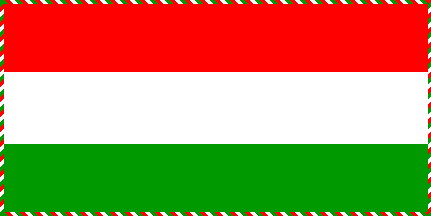
image by Antonio Martins , 19 May 1997
Along with the normal state flag (civil but with coat of
arms), I saw in various public buildings a 2:1 red-white-green
flag with no charges and a distinct fringe of those colors. Any
info?
Antonio Martins, 9 May 1997
Fringed flags are quite often in Hungary, as I have noticed -
either with coat of arms or without it, even the flags hoisted
outside. But, maybe, there is some significanse, since two flags
were hoisted?
Željko Heimer, 10 May 1997
Off the top of my head, I'd say it's a variation on the civil
flag. My scouts' regiment regimental flags all are
'national fringed'.
Georges Kovari III, 19 June 1999
![[Hungarian flag after 1989]](../images/h/hu-1990s.gif)
image by Željko Heimer, 3 November 2001
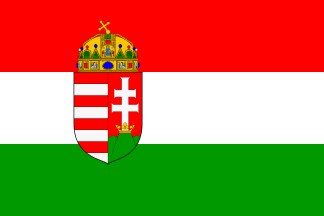
image by Željko Heimer, 3 November 2001
According to the Hungarian Constitution, the flag of Hungary
is a red-white-green tricolor. However, the tricolor with the
coat of arms in it is more or less used as the de facto national
flag. Namely, on national holidays,about 30-70% of the hoisted
national flags are bearing a coat of arms. These coat of
arms-decorated flags can be found both on state or government
buildings and on private houses. The choice between coat of arms
and none-coat of arms flags IMHO depends chiefly on the political
views of the one who hoists it: between 1990-1994, when a
conservative government was in power, almost all flags hoisted
were with coat of arms. Between 1994-1998 , the ratio of flags
with coat of arms decreased form 80% to 30%. The 1994-1998
Government used almost exclusively the tricolor without the coat
of arms. Since 1998 (neoconservative-bourgeoise-right-wing
Coalition), government uses the tricolor with coat of arms again
(along with the EU flag). Private "flag hoisters" tend
to follow the trend, but very loosely. An exception: on the
Parliament building, there has been hoisted the none-coat of arms
version only.
On the other hand, in souvenir stores only coat of arms flags are
sold. On none-holiday occasions (e.g., supermarkets hoisting
their logo flag, the national flag, etc.), both coat of arms and
none-coat of arms flags are hoisted, 60% vs. 40%. The coat of
arms flag is, IMHO, not a state flag, since its use is
nationwide, ranging from the government to every storekeepers
fifth cousin. I would call "it de facto national flag",
from the above reasons.
David N. Biacsi, 4 Februar 1999
The coat of arms flag is widespreadly used without official
sanction, both by government and civilians, and can be considered
as "de facto" flag variation. I guess that it is
indicative that the flags used in very official occasions (as is
the example of the Parliamen building), only the simple tricolour
is used. It is to be noted that as often as not, the coat of arms
on the flag is only on obverse, reverse being simple tricolour!
Željko Heimer, 18 October 1999
At on the village hall of Bakonyszucs/Sitsch, I saw an
Hungarian flag (1:2) with the coat of arms on the hoist side
about in third of its length.
Istvan Molnar, 2 July 2001
The flag with coat of arms is optional variation of the
national flag, and not at all the state flag. According to the
law the coat of arms "could be" set in the tricolour,
but it is not prescribed how - place is not mentioned, nor
orientation (rotation) nor size, and in practice many variations
may be observed, all equally acceptable.
Željko Heimer, 13 July 2001
According to Album 2000 [pay00]
- Alternative National Flag (CS-/CS- 2:3) - Armand chose to show
the version with coat of arms in the middle, while I prefer the
one off-set to hoist. Both are correct, as well as a
number of other variations...
Željko Heimer, 2 November 2001
The law alowes possibility that the coat of arms is set in the
flag, but it does not specify where, how oriented and how big -
therefore I don't think it says anything about "only on
white".
Željko Heimer, 17 November 2001
The plain tricolor IS our state flag yet. Back to 2001 our
semi-right wing party was ?n government, and they 'unofficially'
re-adopted the version with the Kossuth Coat of Arms in it, with
the Hungarian holy crown on top of it. The new flag, with the
Kossuth Coat of Arms in the middle, was only 'unofficially
adopted'. Theres NO rules for that. Now we have a semi left
winged government, so the countrywide use of the Kossuth Coat of
Arms' tricolor is reduced a bit.
Palkó Dániel, 20 March 2006
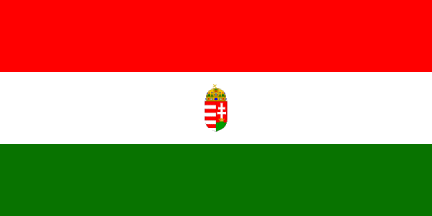
image by István Molnár and Željko Heimer,
6 November 2001

image by István Molnár and Željko Heimer,
6 November 2001
An Hungarian flag with the coat of arms only on the white
stripe in a photo taken in the
Pentecostal Festival in Csíksomlyó (part of
Miercurea-Ciuc/Csíkszereda city) in 2001. On the Home Page of
Miercurea-Ciuc/Csíkszereda: <clmc.topnet.ro>.
István Molnár, 19 September 2001

photo by Rodney Boyd, 23 August 2005
The premises of a car dealership next door to my office in
Toronto, Canada, are regularly festooned with different
decorations. This month it's flags of various
countries. One of them is the Hungarian
"state" flag. It has the coat of arms in the center,
but this is surrounded by two branches, much like the two olive
branches on the UN flag. The
left- and right-hand branches are different - one has what look
to me like acorns on it, and the other has something else. I have
no idea to what extent this flag may or may not be used in
Hungary itself, but it had to come from somewhere, so someone
will probably want to check it out.
Mark Brader, 23 August 2005
Both oak leaves and olive leaves are associated with Hungarian
historical flags - our site shows some examples at Hungary - Historical Flags (1848) and Hungary - Historical Military Flags (1848).
The second of these shows leaves very much like on the flag
depicted, with oak leaves on one side and olive leaves on the
other, although confusingly the text underneath refers only to
the olive leaves. Never heard of the wreaths used on a national
flag before though!
James Dignan, 25 August 2005
I believe this is a "state" flag, but perhaps more
of a de facto than a de jure variant. I have
one of these flags in my collection, among a number of other
Hungarian flags, and I believe it is a "state" flag.
While those above may be the official government ones, the
Catholic communities and Protestant communities use two different
variants. The Catholics have the coat of arms
supported by two angels (as in Regent's
Standard, but with the small shield, on a tricolour
background, etc.). The Protestant variant has the coat of arms
wreathed by a branch of oak (hence the acorns), and bay (AKA
laurel). That's it from this side of the Atlantic.
Georges G. Kovari III, 25 August 2005
According to the Album des Pavillons there is one Hungarian
flag with awreath on it (consisting of two different branches) -
the naval ensign.
Christopher Southworth, 27 August 2005
Here is a photo taken
yesterday in Mohács, Baranya county showing Hungarian Coat of
Arms with Angels in use.
Istvan Molnar, 4 September 2005
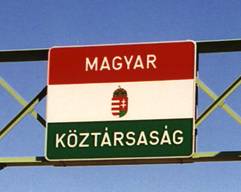
photo by Paul Lorton, 20 September 2004
The flag with the coat of arms was also used on Hungary's
border crossings before the country joined the European Union in
May of this year. The sign used to read "Magyar" in the
red, and "Köztársaság" in the green, with the coat
of arms in the white. I believe this was used on all of the
borders. The photograph above is on the
Hungary-Slovakia border between Esztergom, Hungary and Stúrovo
(Párkány), Slovakia. Now, since Hungary is part of the EU, the
sign has been changed to a blue background with the 12 EU stars
and the words "Magyar Köztársaság" Republic of
Hungary) in the center.
Paul Lorton, 20 September 2004
Note that this "flag" is only a table (made of
aluminium, or steel).
István Molnár, 17 October 2004
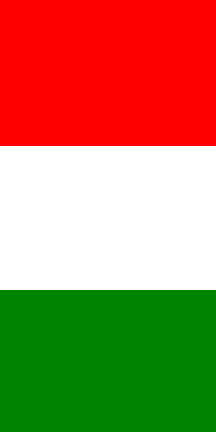
image by István Molnár, 8 May 2001
Yesterday I have seen this short Hungarian flag in Sárvár.
It is a flying flag, not hanging one!
István Molnár, 8 May 2001

image by Antonio Martins, 24 April 1999

image by Istvan Molnar, 15 August 2001
Today was the Millennium ceremony in Esztergom and I have seen
this flag flying on the walls beside the Millennium Statue.
István Molnár, 15 August 2001
This flag is flying below the Millennium Statue of the county.
Maybe it will be a new tradition. Historical form with the
tricolour.
István Molnár, 26 August 2001

image by Mladen Mijatov and Tomislav Todorovic,
27 November 2007
The national flag of Hungary with dark shades of red and green
colours was shown on the photo from a presentation of the Hungarian Justice and Life Party, which
was published in Serbian magazine "Evropa" (ISSN
1820-0761), issue #45 of 2005-02-17, p. 28; at the right-hand
side of the photo, several such flags were hung on the wall. At
the party web site, such flags might
have been seen on different photos. The same is also true for
numerous photos at the site of Sixty-four
Counties Youth Movement. It seems that such flags are often
used by extreme right-wing organizations, although the reason for
use of such dark shades of colours is not widely known yet.
Tomislav Todorovic, 27 November 2007

image by Antonio Martins, 24 April 1999
According to Res. No. 51/1957 (VIII.18.)/ at <www.kff.hu>,
the Hungarian flag for use at sea is red-white-green. Ratio 2:3
István Molnár, 4 April 2001
On the page of
the Shipping Authority there was only one law concerning
flags: It is a statute regulation as old as from 18th August
1957, but it still seems to be valid.
In 1§ it prescribes that Hungarian sea-going (!) merchant
vessels shall (1) hoist the r-w-g tricolour in (2) ratio 2:3 and
that they (3) may not use "mast ribbons" (whatever is
meant by that).
2§ states that by this decree the old one from 1950 loses its
validity.
Marco Pribilla, 1 November 2001
I guess that (3) refers to what we call "masthead
pennant" or "war pennant". It seems logical that
merchant vessels are prohibitied these since they as a rule
declare a vessel to be a warship (c.f. the other name
"commission pennant").
Željko Heimer, 2 November 2001
Hungary had got mercantile fleet after treaty of Trianon and
had got a "River Navy".
More information at <www.mahart.hu>,
<www.papernet.hu>,
<www.mateinfo.hu>.
List of Hungarian ships and shipping line at <www.papernet.hu>.
István Molnár,
Law LXXXIII of 1995 about the use of the national symbols of
the Hungarian Republic and the use of names that make reference
to the Hungarian Republic
11. § (1) For the purpose of declaring the pertainance to the
nation, private persons can use the arms and the flag, keeping
the limitations contained in this law.
(2) The use of the arms and the flag is permitted - keeping the
limitations contained in this law in case of: national
holidays, programs in relation with national holidays and other
kind of programs (political, economical, scientific, etc.),
commemorations of national character, and also casual use for
giving military honors.
(3) In cases specified in paragraphs (1) and (2), the arms and
the flag can be used also in their historical forms.
(4) The use of the arms on the flag is permitted in all cases -
and with the same conditions -, when the use of the arms is
permitted by the law.
Ivan Marinov, 11 January 2001
Constitution of Hungary - paragraph 76 (at <www.parlament.hu>):
The flag of Hungary is red-white-green.
Law LXXXIII. /1995/ about the symbols of Hungary at <www.complex.hu/T9500083.HTM>
Law XXXVIII. /2000/ at <www.complex.hu/kzldat/T0000038.HTM>.
Istvan Molnar, 23 March 2001
No. 132/2000. (VII.14.) order of the Government about the
national flag (at <www.konfoderaciok.hu>):
Ratio of the flag: 1:2 . On the Appendix you can find measures of
flags and flag-poles sizes (on the end of the page).
István Molnár, 23 March 2001
The first law about the flag was the Law XXI in 1848. It said:
"1. The national colour and the Coat of Arms of the country
restituted to traditional law" [No data of ratio. The
official used flag was the 1:2 flag. The laws later renewed it!]
In the Constitution (XXth Law in 1949 modified by the XL Law in
1990) at <www.mkogy.hu>:
"76. § The flag of the Republic of Hungary contains three
equal horizontal red,white and green stripes. [No data of ratio.
It was traditionally 1:2]
Law LXXXIII (1995) about the using of the national symbols says
nothing about the ratio too.
Resolution No. 132/2000 (VII. 14.) of the Government is defined
the dimension of the flag - NOT modified, only determined.
The official dimensions are:
1. 100x200 cm 2,5 m (flagstaff)
2. 150x300 cm 3,5 m
3. 200x400 cm 4 m
You can find the Resolution No. 51/1957 (VIII. 18) of the
Government from 1957 which defined the flag using on the sea (its
ratio was 2:3!) at <www.kff.hu>.
Istvan Molnar, 13 Auguat 2001
I managed to find a Hungarian government decree (132/2000,
issued 14.7.2000) complementary to the 2000 flag law. In the
appendix the exact sizes of the flags to be used at government
buildings are prescribed according to mast length and the flags
are indeed all in ratio 1:2. (The decree even states that the
flag is to be cleaned at least every three months and replaced by
a new one once a year!)
On the other hand, there is the decree of 1957 <www.kff.hu>
which prescribes the 2:3 tricolour for merchant vessels. The
constitution and the flag laws of 1995 and 2000 say nothing about
the ratio.
So according to this information it seems that BOTH 1:2 and 2:3
are official, but for different use. The 2:3 tricolour is the
merchant ensign, and 1:2 is some kind of state flag on land. For
the ratio of private flags used on land, however, I have not
found any prescriptions, so I guess anything goes...
Marco Pribilla, 18 November 2001
coat of arms in a 1:1 white backgound with green red
alternated triangle border. It appears in Smith78.
Antonio Martins, 7 May 1997
These are supposed to be wolf-teeth.
Nahum Shereshevsky, 11 May 1997
It was very interesting for me to see that in Hugary, flags on
half mast as a symbol of mourn are NOT USED AT ALL. Last Sunday
was officially declared as a national mourning day due to a bus
accident in Styria, Austria. All buildings hoisted black flags,
and there was none national flag, full mast or half mast, at all.
What kind of tradition (or lack of it) may it be that, instead of
half mast national flags, solely black flags are hoisted as a
sign of mourning
David N. Biacsi, 4 Februar 1999
I read in one of my books (either Sisa's Spirit of Hungary
or Marek's The Eagles Die) that when Empress Elizabeth
was assassinated in Lucerne on Sept. 9 1898, black flags were
flown all over Budapest. As to whether they were also flown
throughout Hungary, I don't know, but I wouldn't doubt it.
Georges Kovari III, 4 Februar 1999
I am speculating here, but if the tradition (or lack of it, as
you put it) is anything similar to Croatia, and I believe it is
then an explanation similar to this could be given. Most of the
flags that are hoisted on private houses and blocks are of a kind
where the staff is obliquly attached to the house, and the flag
is attached to the sfatt either by the way of a sleve or nails.
Any of the two would make it totally unpractical to put the flag
on half-staff - it would require either resewing or getting the
nails out. In any case, as these staff would be of, say, 2 meters
long, a half-masted 1 meter wide flag would not look very well on
it anyway. It is therefore, that the solution of blackflag is
used.This is how I explain this around here, and maybe it would
be similar in Hungary.
Željko Heimer, 5 Febuary 1999
the colour of mourning has always been black in Hungary. It is
a tradition that has been in existence for centuries. They say
its roots have not been traced yet. So on the occasion of the
death of Queen Elizabeth in the last century it was flown because
it had been flown on such occasions ever since people could
remember not because it suddenly came to somebody's mind.
Albert Lugosi, 7 June 2000
When I was in Budapest last year, a black flag was hoisted on
the building of the Academy of Sciences after the death of a
famous scientist.
Ivan Sache, 15 September 2001
In Budapest, it is customary to fly black flags upon the death
of an important person. Last year, when a parliamentarian had
died in his nineties, the Parliament building - probably the most
attractive in the world - flew black flags alongside the
Hungarian national flag, on smallish flag poles at an oblique
angle from the building. This manner of flagpole is also
customary in Hungary on public buildings, in addition to a
vertical flagpole.
Colin Dobson, 23 June 2004